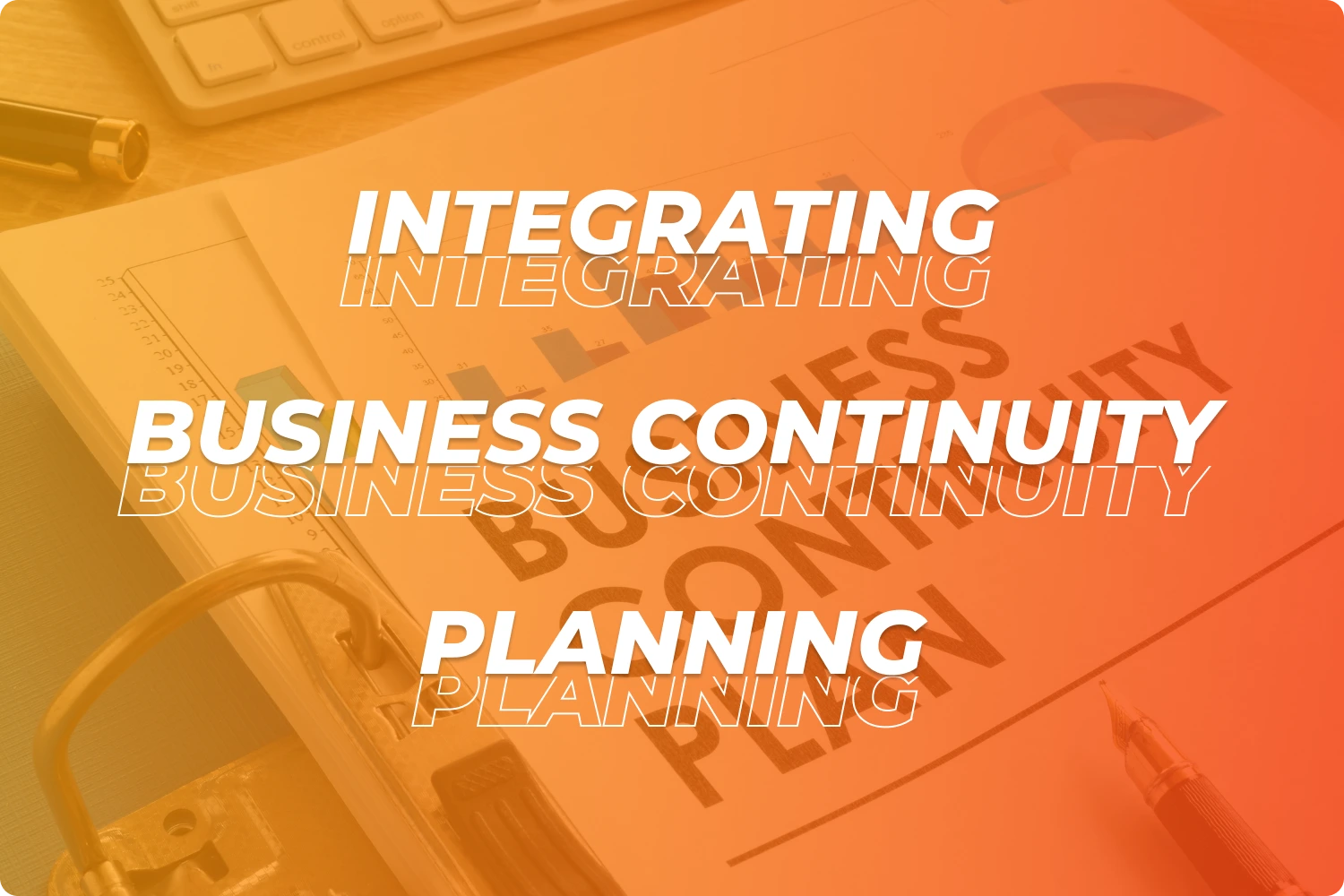The IT strategy I depend on isn't just about choosing the latest technology. It's about making sure my business stays resilient when the unexpected strikes. With 2025 bringing a wave of sophisticated threats and uncertainties, I see business continuity planning (BCP) as the backbone of my IT approach. Instead of only thinking about what tools or networks to buy, I now focus intensely on how to keep operating when things go wrong, whether it's a ransomware attack, critical hardware failure, or even a natural disaster.
Understanding Business Continuity Planning and Its Critical Role in Modern IT Strategy
Business continuity planning is my blueprint for ensuring my company can keep delivering value, no matter what disruption comes our way. This means developing and maintaining clear, actionable steps so essential operations don't suddenly grind to a halt during a crisis.
When I work on a BCP, I make sure it covers not just IT systems, but also crucial business functions like supply chains, communications, HR procedures, and backup sites. It's a living document that evolves with my business, especially as technology and risk landscapes shift. In my experience, an effective BCP is practical, detailed, and clearly assigns responsibilities so everyone knows their role when an incident strikes.
BCP is intrinsically connected with IT strategy and disaster recovery for IT operations. Without it, even the smartest IT investments can crumble the moment a sophisticated attacker takes down a server or flooding hits the main office. Instead, I build my IT planning around response and recovery capabilities, making digital infrastructure more robust and the entire business more resilient. For comprehensive BCP basics, the US Department of Homeland Security provides valuable guidance, while regional sources like the Monetary Authority of Singapore emphasize resilience best practices for Asia-Pacific businesses.
The New Threats and Risks Facing IT Strategy and Business Continuity in 2025
Your planning needs to keep pace with rapidly evolving risks across the digital landscape. Here are the major issues that can affect business continuity and IT resilience best practices in 2025:
Advanced Cyber Threats
From ransomware to supply chain attacks, cybercriminals deploy increasingly sophisticated techniques. Some groups now target cloud services and managed IT providers to create cascading damage across multiple organizations.
The 2023 attack on major APAC logistics companies led to days of delayed shipments, exposing how vulnerable our interconnected logistics networks have become.
Dependency on Cloud and SaaS Platforms
As more operations migrate online, risk shifts to how well service providers handle outages. Prolonged disruptions on a single cloud provider can paralyze entire business units.
Cloud outages in 2024 cost Asian businesses millions in lost productivity and revenue, as seen during the November 2024 Salesforce outage that disrupted more than one hundred companies and government bodies across Asia Pacific.
Complex Global Supply Chains
Global suppliers amplify your exposure to disruptions from political instability, public health crises, and shifting international regulations. During the Suez Canal blockage, I dealt with software delays and hardware shortages for weeks—a stark reminder that IT resilience extends far beyond the data center.
Business Continuity in Hybrid Work Environments
Teams now work from home, co-working spaces, and everywhere in between. This distributed model means protecting more devices, endpoints, and networks than ever before.
If your VPN fails or there's a widespread power outage, team productivity could plummet unless you've planned ahead with redundant connectivity options and clear remote work protocols.
Regulatory and Compliance Requirements
In Asia-Pacific, regulations like Singapore's PDPA and Australia's Privacy Act continue evolving rapidly. You need up-to-date incident response and continuity plans ready to share with regulators at a moment's notice.
Failing these requirements can result in hefty fines, loss of business licenses, or permanent reputational damage.
Given these escalating risks, prioritizing BCP within your IT strategy has become a fundamental requirement, not an optional extra.
Why Integrating Business Continuity Planning into Your IT Strategy Delivers Real Results
How Business Continuity Supports Your IT Strategy: Reducing Downtime and Financial Impact
I've learned that losing access to critical systems, even briefly, can trigger massive losses. The average cost of downtime in the Asia-Pacific region far exceeds $50,000 per hour—in fact, high-impact outages cost ASEAN businesses a median of $2.5 million per hour, according to New Relic’s 2024 Observability Forecast [The Asian Business Review].
When you have clear continuity playbooks and tested backup systems, your staff know exactly what steps to take, eliminating guesswork and panic. For one of my clients, a swift failover to a backup cloud provider during a critical outage helped avoid customer complaints entirely. They never even noticed the primary system was down.
Protecting Data and Ensuring Rapid Recovery
Data now forms the core of modern business operations, and ransomware or accidental loss can be catastrophic. Implementing practices like the 3-2-1 backup rule gives you reliable recovery options:
- Three copies of important data
- Two different types of storage media
- One offsite backup location
I test restore procedures regularly. There's nothing worse than discovering corrupt backups during an actual crisis. Ransomware attacks on law firms in Asia-Pacific have shown that those with isolated, untouched backups can recover within hours, while others without such protections have struggled for weeks and, in some cases, permanently lost sensitive case records.
Maintaining Customer Trust and Protecting Brand Reputation
Nobody wants to work with a company plagued by constant interruptions. When you recover swiftly after a disruption and communicate transparently, clients see your business as dependable and professional.
Proactive status updates reassure partners and customers during incidents. When a regional e-commerce brand suffered a DDoS attack, their clear public response and regular status updates helped retain customer trust, even as competitors rushed in with opportunistic discounts.
Meeting Regulatory Expectations and Compliance Standards
Many industries require written continuity and recovery plans, regular testing documentation, and comprehensive staff training records. If regulators come calling, having a robust BCP demonstrates your company's commitment to operational excellence.
It also protects against penalties or legal issues that can arise following data loss or extended outages. In financial services, the Monetary Authority of Singapore mandates detailed recovery planning as part of technology risk management, a standard now being adopted across the region.
Building Organizational Resilience and a Culture of Preparedness
A strong BCP does more than restore systems. It cultivates a mindset where teams are always ready to adapt. This preparedness enables handling both planned changes and sudden surprises, whether that's shifting workloads during a regional typhoon or managing the fallout when a critical supplier goes bankrupt overnight.
Rather than just reacting, your teams spot risks earlier and respond in more creative, focused ways. Additionally, cultivating preparedness boosts internal morale and demonstrates that everyone's role matters when the unexpected strikes.
The Core Elements of Effective IT Business Continuity Planning
Build your BCP around clear, practical components to ensure comprehensive coverage without drowning in excessive documentation. These areas form the backbone of effective planning:
Risk and Impact Assessments
Start by mapping out which threats could cause the most damage and which business functions can't afford extended downtime. This helps you set recovery priorities and focus investments where they matter most.
Multiple Backups and Redundancy
Having multiple independent backups, both onsite and offsite, is absolutely critical. For key systems, consider real-time replication to failover sites for near-instantaneous recovery.
Incident Response Procedures
Your plans should include detailed, step-by-step guides for common scenarios:
- Cyber incidents and data breaches
- Loss of internet connectivity
- Critical system failures
- Physical site disasters
These guides must be simple enough for anyone to execute under pressure.
Clear Roles and Communications
Assign unambiguous responsibilities to prevent confusion during crises. Keep contact lists and escalation channels current so the right people get critical information immediately. Pre-written communication templates help maintain consistency during high-stress incidents.
Testing and Continuous Improvement
Regular tabletop exercises or live simulations help your teams discover gaps before real emergencies occur. Every test should conclude with an honest review and actionable plan updates.
Vendor and Supply Chain Coordination
Your BCP must account for critical software and hardware vendors you depend on. Work with them proactively to understand their continuity measures and service limitations.
Frameworks from sources like the ISO 22301 standard and the Asia Cloud Computing Association offer practical methodologies to elevate your practices.
Practical Steps to Get Started with Business Continuity in Your IT Strategy
Getting started doesn't need to feel overwhelming. Break down the process into these manageable steps:
1. Inventory Your Critical Systems and Dependencies
List all business-critical applications, data sources, and key supplier relationships. This inventory creates a comprehensive map of what needs the most protection.
2. Perform a Risk and Business Impact Assessment
Work with IT and business leaders to evaluate what would happen if each system went offline. This reveals your recovery priorities and helps define acceptable downtime windows (RTOs and RPOs).
3. Draft the Plan and Assign Clear Roles
Document specific, well-communicated steps for each disruption scenario to eliminate uncertainty when you're under pressure. Make sure everyone knows their responsibilities.
4. Test Early and Test Often
Simple tabletop exercises or live drills allow your team to build confidence and uncover improvement areas before they matter.
5. Review and Update Regularly
Every year, or after any significant change like new technology deployments, vendor switches, or office relocations, review and refresh your plan. Learn from nearby incidents or industry case studies to stay ahead of emerging threats.
Comprehensive checklists and implementation guides are available from resources like BCP Asia and CSA Singapore.
Common Obstacles in BCP Implementation and How to Overcome Them
Even with the best intentions, I've encountered several sticking points when ensuring BCP effectiveness:
Budget Constraints
Investing in backup systems or redundant infrastructure can be challenging to justify until a crisis occurs.
Solution: Focus on cost-effective options like cloud-based backups and build a compelling business case by quantifying potential downtime losses.
Complacency and Awareness Gaps
Some colleagues get absorbed in daily operations and forget about lurking risks.
Solution: Conduct regular training sessions, send periodic reminders, and share real-world incident examples to keep business continuity top of mind.
Complex Supplier Networks
Critical IT components rarely fall under your direct control.
Solution: Insist on reviewing vendors' BCPs and confirm they can communicate rapidly if disruptions occur on their end.
Keeping Plans Current as Business Evolves
Growing companies or mergers can quickly outdate existing plans.
Solution: Establish a regular review schedule and integrate BCP updates into your IT change management process.
Testing Fatigue
Running exercises too frequently or without clear objectives can create burnout.
Solution: Keep tests short, focused, and relevant to real risks you've identified in your business or industry.
The more you integrate BCP into ongoing IT and business planning, the less it feels like an add-on burden.
Advanced Strategies for Strengthening IT Continuity and Resilience in 2025
Once you've mastered the basics, explore these advanced approaches to elevate your continuity planning:
Automate Key Backups and Monitoring
Modern backup tools enable scheduling, encryption, and automated monitoring of data copies for continuous protection. Real-time monitoring with automatic failover for critical applications helps minimize downtime to seconds rather than hours.
Adopt Zero Trust Security Models
By limiting system access granularly, even if attackers breach one network segment, it becomes exponentially harder to impact your entire business. For remote and hybrid teams, this Zero Trust model is gaining rapid adoption across successful organizations, including in APAC, as highlighted by Microsoft Security.
Integrate Crisis Communication Tools
Deploy applications that send instant notifications via multiple channels:
- SMS alerts
- Push notifications
- Automated phone trees
- Collaboration platform integrations
This ensures no one remains uninformed during critical incidents.
Leverage Industry Threat Intelligence
Join information-sharing groups like FIRST.org to spot emerging threats early and learn from others' recovery experiences. Connecting with industry peers ensures you're not reinventing solutions to common challenges.
Combining these advanced strategies helps transform your organization from merely having a plan to building true adaptive resilience across every department.
Real-World BCP Success Stories from Asia-Pacific Businesses
I've witnessed several companies in the Asia-Pacific region implement solid BCP measures with remarkable results, and seen the devastating price others pay for neglecting them.
Case Study: Business Continuity Planning in Action—Lessons from Singapore’s 2024 Ransomware Incident
In April 2024, a ransomware attack on Toppan Next Tech, a major Singapore-based printing and data vendor, exposed customer data from leading banks including DBS and Bank of China’s Singapore branch. While the banks’ core systems and funds were not compromised, the incident underscored the critical importance of robust business continuity planning (BCP) and vendor risk management in the financial sector.
Banks that had comprehensive BCPs in place, including regular disaster recovery tests, secured offsite backups with air-gap protection, and strict access controls with network segmentation, were able to respond swiftly and transparently. These measures enabled them to:
- Quickly switch to backup systems and alternative workflows
- Communicate promptly and clearly with customers about the incident
- Restore most affected services with minimal disruption
Transparent communication and rapid recovery helped maintain client confidence, demonstrating that a proactive approach to BCP can turn a potential crisis into an opportunity to reinforce trust.
Learn more about the incident:
- Channel News Asia: DBS, Bank of China Singapore customers' data extracted after printing vendor hit by ransomware attack
- Business Times: Ransomware attack hit a vendor to DBS. What is ransomware and how does it affect companies?
Case Study: Manufacturing Resilience Against Natural Disasters
Thailand’s electronics manufacturers have faced repeated disruptions from severe flooding, including the 2022 monsoon season. Some companies learned the hard way that onsite-only backups were vulnerable when floodwaters damaged both their primary systems and local backups, leading to weeks of downtime. After investing in geographically distributed cloud storage and regularly updating their business continuity plans, these manufacturers were able to maintain operations seamlessly when flooding struck again. This shift highlights the importance of offsite data protection in disaster-prone regions (ReliefWeb: Thailand Monsoon Flood 2022 – Final Report).
Case Study: Remote Work Success During Pandemic Lockdowns
When sudden lockdowns hit Jakarta in 2020, only companies with tested remote-work continuity plans, such as clear work-from-home policies, VPN failover processes, and cloud-based communications, kept employees productive and continued delivering for clients. Organizations lacking these preparations faced missed deadlines and lost contracts as operations stalled (The Jakarta Post).
Lessons from across the region demonstrate that BCP isn't just about headline disasters. It's about ensuring your business can weather disruptions both large and small. Continuity creates competitive advantage and enables capitalizing on opportunities when competitors are paralyzed.
Frequently Asked Questions About BCP and IT Strategy Integration
I've received numerous questions while helping businesses across Asia-Pacific integrate BCP into their IT strategies. Here are answers to the most common concerns:
How do I make BCP part of my ongoing IT investments?
Include continuity and disaster recovery requirements in all vendor contracts and technical roadmaps. Evaluate every new system's recovery capabilities before deployment. This habit ensures readiness is built in from the start, not bolted on as an afterthought.
How often should I test my business continuity plan?
Run tabletop or simulation exercises at least twice annually and always test when you implement major IT infrastructure changes or significant business process modifications. Regular testing reveals blind spots while keeping teams comfortable with emergency protocols.
Who should own BCP in my company—IT department or business leadership?
While IT typically drives technical implementation, real success comes when business and IT leaders co-own the initiative. Involve all department heads in reviews to ensure nothing critical gets missed. This collaborative approach builds a culture where everyone takes responsibility for organizational continuity.
What's the quickest way to improve my existing plan?
Start by reviewing recent incidents or industry events for lessons learned. Update backup procedures based on current best practices, and ensure staff know their roles through focused refresher sessions. Implementing small, targeted improvements often delivers significant benefits during actual crisis scenarios.
Building a Stronger, More Resilient Business with BCP-Integrated IT Strategy
By embedding business continuity planning into your IT strategy, you're taking a practical, forward-thinking approach to maintaining operations and protecting value, regardless of what challenges 2025 brings. Rather than treating BCP as a compliance checkbox, embrace it as a core component of technology investment, risk management, and customer service excellence.
This integrated approach builds stakeholder trust, strengthens brand reputation, and protects the livelihoods of employees and partners. Your teams stay agile, prepared, and proactive, positioning the organization for long-term success.
The tools, resources, and proven methodologies are readily available, from international BCP standards to local industry associations. By building on established frameworks and making BCP a regular part of strategic planning, you'll be prepared to bounce back from whatever comes next, securing a strong future for your business in an increasingly unpredictable digital landscape.
Ready to strengthen your IT strategy with comprehensive business continuity planning?
The time to act is now, before the next disruption tests your preparedness.
Visit FunctionEight.com to learn how our IT experts can help you build resilience, reduce downtime, and prepare for whatever 2025 brings.









